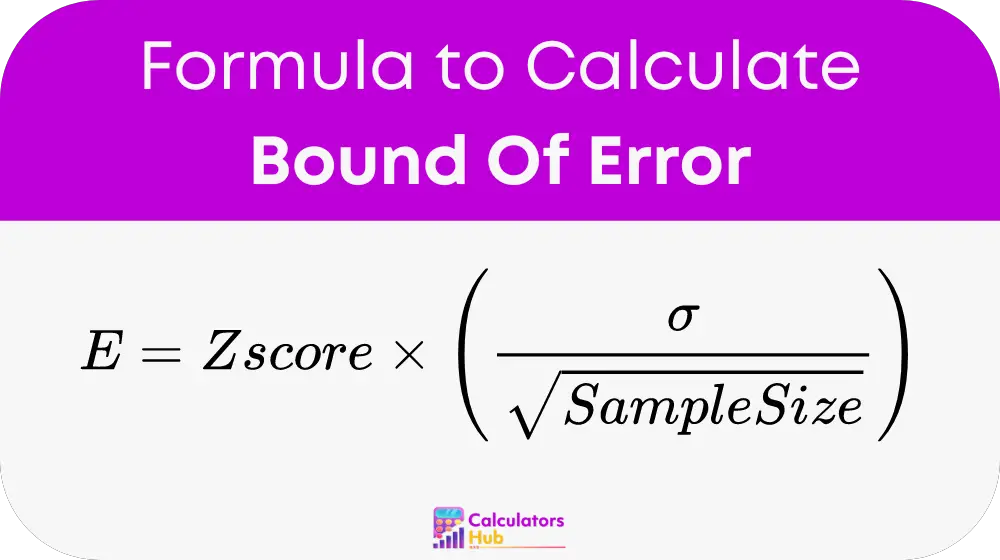The Bound of Error Calculator, also known as the margin of error calculator, helps researchers, statisticians, and analysts determine the margin of error in a statistical study or survey. The margin of error is a critical component in understanding how accurate your sample results are when compared to the entire population. It gives you a range of values that likely contain the true population parameter based on your sample data, offering a way to express the uncertainty in your results.
This tool is widely used in survey research, market analysis, polling, and various other fields where sampling is necessary. By using the Bound of Error Calculator, you can determine the degree of confidence you should have in the results of a survey or study.
Formula of Bound Of Error Calculator
The formula used to calculate the bound of error (margin of error) is:

Variables:
- E: Bound of Error, also known as the margin of error, represents the range around the sample statistic that is likely to contain the true population parameter.
- Z: Z-Score, a value that corresponds to the desired confidence level (e.g., 1.96 for 95% confidence, 2.58 for 99% confidence).
- σ: Standard Deviation, the measure of the variability in the population.
- n: Sample Size, the number of observations in the sample.
Key Points:
-
Z-Score varies based on the desired confidence level. For example:
- A 95% confidence level corresponds to a Z-score of 1.96.
- A 99% confidence level corresponds to a Z-score of 2.58.
- Standard Deviation (σ) represents how spread out the values are in the population. If the standard deviation is unknown, it can be estimated from the sample data.
- Sample Size (n) is a critical factor in determining the bound of error. A larger sample size reduces the margin of error, while a smaller sample size increases it.
Common Terms and Reference Table
Here’s a table of common terms used in calculating the bound of error:
| Term | Definition |
|---|---|
| Bound of Error (E) | The range within which the true population parameter is expected to lie. |
| Z-Score (Z) | The number of standard deviations away from the mean for a given confidence level. |
| Confidence Level | The probability that the true population parameter lies within the margin of error. |
| Standard Deviation (σ) | A measure of how spread out the values in a population are. |
| Sample Size (n) | The total number of observations in the sample. |
| Population | The entire group being studied or surveyed. |
Example of Bound Of Error Calculator
Let’s go through an example to demonstrate how the Bound of Error Calculator works.
Suppose a market research company conducted a survey to estimate the average spending on groceries per month. They took a sample of 500 individuals and found a standard deviation of $50. The company wants to estimate the bound of error for a 95% confidence level.
Step 1: Apply the Formula
Bound of Error (E) = Z-Score (Z) × (Standard Deviation (σ) ÷ √Sample Size (n))
For a 95% confidence level, the Z-score is 1.96.
Substitute the values:
E = 1.96 × (50 ÷ √500)
Step 2: Calculate
First, calculate the square root of the sample size:
√500 ≈ 22.36
Now, divide the standard deviation by the square root of the sample size:
50 ÷ 22.36 ≈ 2.24
Finally, multiply by the Z-score:
E = 1.96 × 2.24 ≈ 4.39
The bound of error (margin of error) is approximately $4.39. This means that the true average spending on groceries per month is likely to be within $4.39 of the sample average with 95% confidence.
Most Common FAQs
The bound of error represents the range within which the true population parameter (such as a mean or proportion) is expected to fall. It provides a margin around the sample estimate, indicating how much uncertainty exists due to the sample size and variability in the data.
You can reduce the margin of error by increasing the sample size. Larger sample sizes provide more accurate estimates of the population parameter, resulting in a smaller margin of error. Additionally, reducing variability in the data (standard deviation) also decreases the margin of error.
The confidence level determines how certain you are that the true population parameter lies within the bound of error. A higher confidence level (such as 99%) increases the Z-score, which in turn increases the margin of error. Conversely, a lower confidence level (such as 90%) reduces the margin of error but also reduces the certainty of the result.